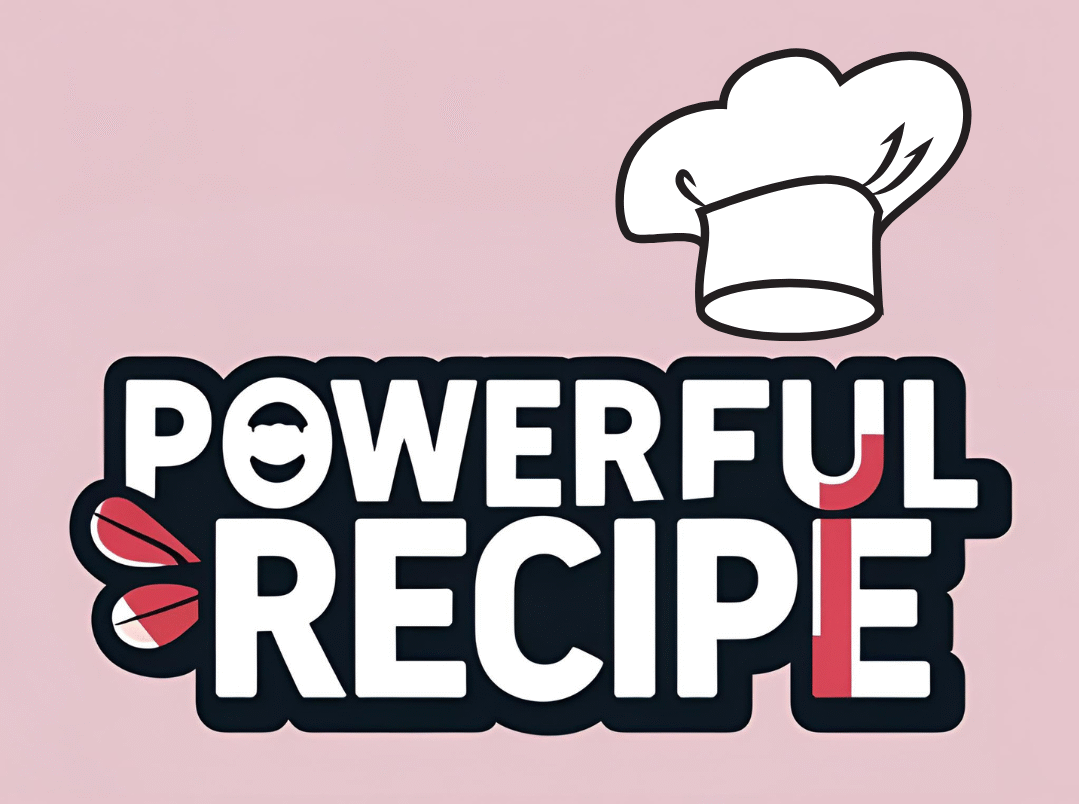If you’re a fan of light, airy breads that puff up magically in the oven, then you’re already familiar with popovers. But what if we told you there’s a way to make them even better? Enter cornmeal popovers — the deliciously golden twist on a traditional favorite. These rustic yet elegant treats combine the comforting crunch of cornmeal with the pillowy softness of classic popovers, creating a texture and flavor explosion that’s both nostalgic and new.
Cornmeal popovers have recently gained popularity in home kitchens and restaurants alike, and it’s easy to see why. They strike an ideal balance between hearty and light, blending savory richness with a hint of sweetness. Whether you’re looking for a creative breakfast option, a side dish for soup, or an eye-catching addition to a brunch spread, cornmeal popovers deliver.
In this article, we’ll take you on a journey through the wonderful world of cornmeal popovers. You’ll learn about their origins, understand what makes them special, discover a foolproof recipe, and explore variations to suit every taste. Plus, we’ll share expert baking tips, serving ideas, and even how to make them gluten-free or vegan. By the end, you’ll be inspired to whip up your own batch of these irresistibly golden bites.
Let’s dive into the magic of cornmeal popovers and why they deserve a spot in your baking rotation.🧁🌽🥐✨
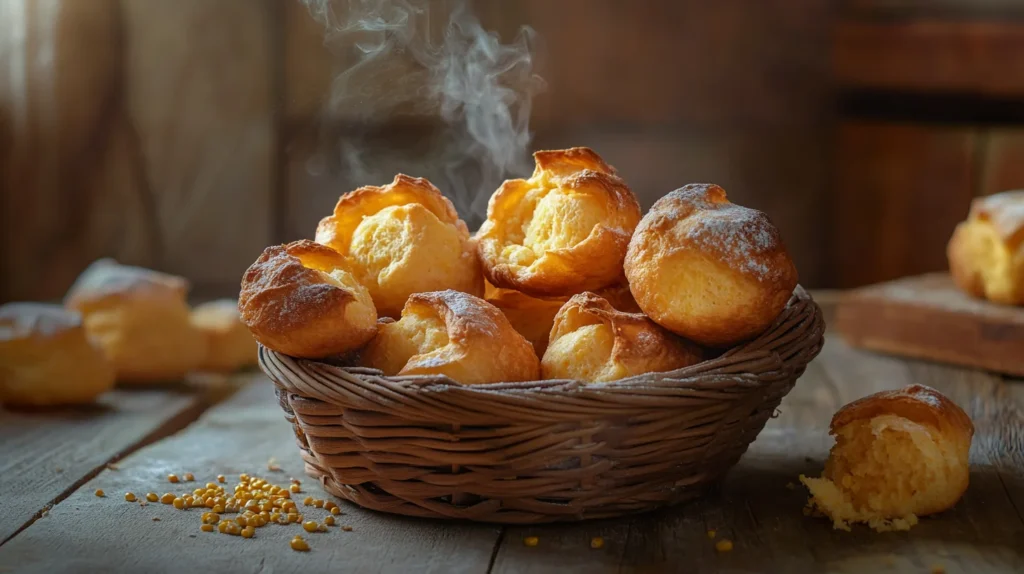
What Are Cornmeal Popovers?
Cornmeal Popovers are a delightful variation of the traditional popover, a light, hollow roll made from an egg-rich batter. The key difference? These popovers are enhanced with cornmeal — a coarse flour ground from dried maize — giving them a heartier bite, a subtle nutty flavor, and a beautiful golden hue. The result is a popover that still rises gloriously in the oven but adds a rustic charm to every bite.
Where classic Cornmeal Popovers tend to be eggy and soft with a custard-like center, cornmeal popovers offer a more complex texture.Cornmeal gives the exterior a golden, crispy finish, while the inside stays soft and light as air. It’s this combination of textures that makes them so appealing to both bakers and eaters alike.
The History of Cornmeal Popovers
Cornmeal Popovers have a rich culinary history, with roots tracing back to Yorkshire pudding in England. Traditionally served alongside roasted meats, Yorkshire pudding used drippings to create a savory, puffed bread. As the recipe crossed the Atlantic, American cooks began experimenting with different fats and flours, eventually leading to the development of the popover.
The name ‘popover’ comes from how the batter rises and spills—or ‘pops over’—the edges of the pan as it bakes.They’ve been a staple in American homes, especially in New England, for generations. Adding cornmeal to the mix is a relatively modern innovation — one that embraces regional ingredients while staying true to the original technique.
The Role of Cornmeal Popovers
Cornmeal Popovers is more than just a texture booster in this recipe — it transforms the entire profile of the popover. Its gritty texture lends a slight crunch to the crust, while its flavor brings a rich, earthy warmth. Depending on the grind, cornmeal can add more or less texture, making it a flexible ingredient for customization.
Beyond taste and texture, Cornmeal Popovers also offers nutritional benefits. It’s a whole grain rich in fiber, antioxidants, and essential minerals like iron and magnesium. Incorporating cornmeal into your baking is an easy way to sneak in a bit of wholesome goodness.
Cornmeal popovers are especially popular in areas where corn is a staple crop, such as the Southern United States. Here, bakers often incorporate local cornmeal into traditional recipes as a nod to heritage and regional flavors. Whether you’re drawing inspiration from Southern cornbread or simply looking to elevate your baking game, cornmeal popovers are a delicious step forward.
Key Ingredients for Cornmeal Popovers
When it comes to baking the perfect batch of cornmeal popovers, success begins with the right ingredients. Each component plays a vital role in creating the signature rise, flavor, and texture of these golden delights. Let’s break it down ingredient by ingredient so you know exactly what you need—and why it matters.
Cornmeal Popovers Types
Cornmeal Popovers is the star of the show, but not all cornmeal is created equal. The texture and flavor of your popovers will vary depending on the grind you use:
- Fine Cornmeal: Offers a smoother texture and is more seamlessly incorporated into the batter. This is ideal if you want a gentle corn flavor without a gritty bite.
- Medium Cornmeal: Strikes a balance between texture and smoothness. It adds character without overpowering the soft interior of the popover.
- Coarse Cornmeal (Polenta-style): For those who love a toothsome crunch. This version brings a hearty, rustic quality, but be mindful—it can make the batter dense if overused.
For most popover recipes, medium-grind cornmeal is the sweet spot. It gives a noticeable texture without interfering with the rise.
Supporting Ingredients
Though Cornmeal Popovers steals the spotlight, the supporting cast is equally essential. Here’s what you’ll need:
- All-purpose flour complements the cornmeal by adding structure and ensuring a balanced texture. Too much cornmeal and you risk a heavy popover; flour helps maintain that signature lightness.
- Eggs: The engine behind the popover’s iconic rise. Eggs provide lift, bind the ingredients, and contribute richness to the final product.
- Milk: Adds moisture and helps create steam during baking, which is critical for that dramatic puff.
- Butter: Brings flavor and helps crisp the edges. Melted butter also contributes to the tender crumb inside.
- Salt: Enhances flavor and balances the natural sweetness of cornmeal.
- Optional Add-ins: Cheese, herbs, or spices can be folded in for extra depth and creativity.
Each ingredient has a job to do. Skimping or substituting without understanding the impact can lead to flat, tough, or overly gritty results.
This blend ensures a light texture with a golden crunch — similar to how recipes like Tortilla Pizza Pockets achieve crispy perfection with a twist.
Step-by-Step Cornmeal Popovers Recipe
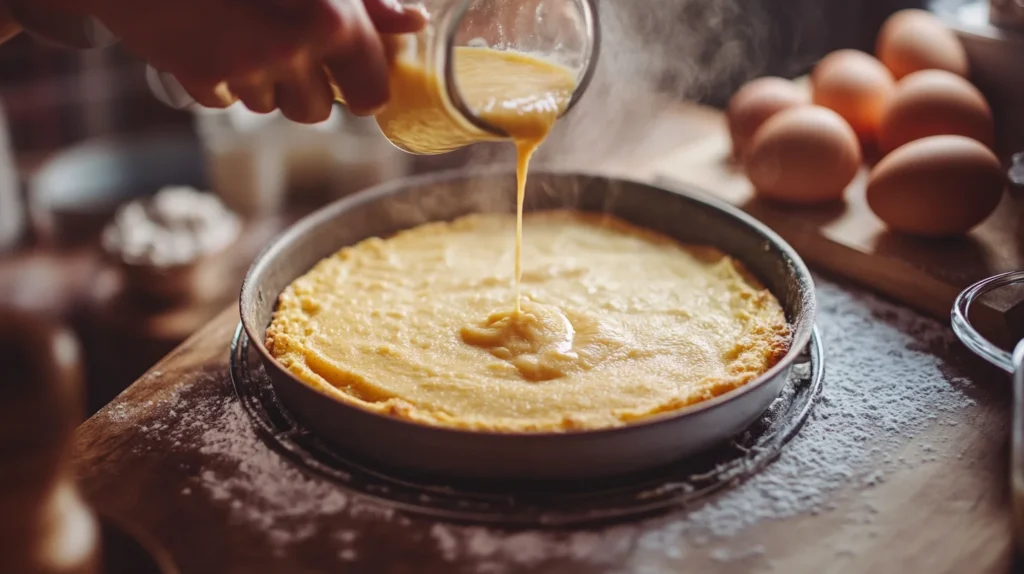
Now that we’ve covered the essential ingredients, it’s time to bring them all together in a simple, reliable recipe that even beginner bakers can master.
Ingredients List
- ¾ cup all-purpose flour
- ¼ cup medium-grind cornmeal
- ½ teaspoon salt
- 1 ¼ cups whole milk (room temperature)
- 3 large eggs (room temperature)
- 2 tablespoons of melted butter, plus a little more for greasing the pan
Preparation Tips
Before we begin mixing, let’s cover a few prep tips that will make a huge difference in your final product:
- Use Room-Temperature Ingredients: Cold eggs or milk will affect how your batter behaves in the oven.Allow all ingredients to come to room temperature for at least 30 minutes.
- Preheating the pan is crucial—it creates the burst of steam needed for the popovers to rise beautifully.
- Grease Generously: Use melted butter or oil to coat each cup of the popover pan thoroughly. This prevents sticking and aids in crisping the edges.
Mixing the Batter
- In a large mixing bowl, combine the flour, cornmeal, and salt by whisking them together.
- Beat Eggs and Milk: In a separate bowl, beat the eggs and milk until fully combined.
- Combine Wet and Dry: Slowly pour the wet ingredients into the dry, whisking gently to avoid lumps. Do not overmix.
- Add Melted Butter: Stir in the melted butter until incorporated. Let the batter rest for 10–15 minutes.
Baking Instructions
- Preheat Oven and Pan: Place your popover pan in a cold oven and set it to 450°F (230°C). Once preheated, carefully remove the pan and grease each cup quickly.
- Fill the Cups: Pour the rested batter into each cup, filling about ⅔ to ¾ of the way.
- Bake in Two Stages:
- Bake at 450°F for 15 minutes (do not open the oven).
- Lower the oven temperature to 350°F (175°C) and continue baking for 20 minutes, or until the popovers are puffed and golden brown.
- Take the popovers out of the pan, carefully pierce each one with a sharp knife to let the steam escape, and allow them to cool slightly before serving.
These cornmeal popovers will come out tall, golden, and slightly crispy on the outside with a soft, airy interior. Delicious as-is or paired with your favorite toppings!
Flavor Variations to Try
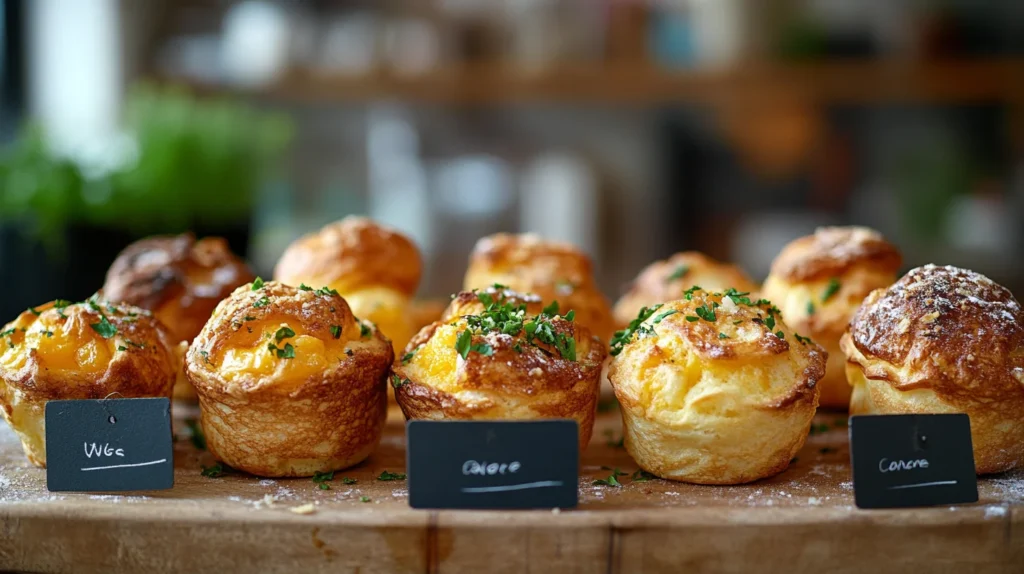
Cornmeal popovers are wonderfully adaptable. Their simple base allows for countless variations, both savory and sweet, that can elevate them from side dish to showstopper. Whether you’re in the mood for something rich and cheesy or light and sweet, there’s a version for everyone.
Savory Additions
Adding savory ingredients to your cornmeal popovers can turn them into the perfect accompaniment for lunch or dinner. Here are some crowd-pleasing combos:
- Cheddar and Chive: Stir in shredded sharp cheddar cheese and finely chopped fresh chives before baking. The cheese melts beautifully into the batter, adding gooey richness, while the chives offer a bright, oniony pop.
- Parmesan and Black Pepper: Aged Parmesan adds depth and a salty tang, while freshly cracked black pepper lends a little heat and complexity.
- Jalapeño and Corn Kernels: Bring some heat with diced jalapeños, and enhance the corn flavor with a handful of sweet corn kernels. This variation complements chili or grilled meats beautifully.
- Rosemary and Garlic: Infuse your batter with finely chopped rosemary and a pinch of garlic powder. These popovers smell incredible in the oven and taste even better.
To incorporate savory elements, simply stir them into the batter after adding the melted butter. Keep add-ins modest to avoid weighing down the batter and affecting the rise.
Sweet Options
Yes, popovers can absolutely satisfy your sweet tooth too! Cornmeal’s natural sweetness pairs well with several indulgent additions:
- Cinnamon and Brown Sugar: Sprinkle a cinnamon-brown sugar mix into the batter or dust it over the tops just before baking for a sugary crust.
- Vanilla and Nutmeg: Add a splash of vanilla extract and a pinch of nutmeg to the batter for a warm, comforting flavor profile.
- Honey Butter Glaze: After baking, brush your popovers with a mixture of melted butter and honey. This gives them a glossy finish and a sticky-sweet touch.
- Cranberries and Orange Zest: Fold in a few chopped dried cranberries and a teaspoon of orange zest for a fruity, festive version—perfect for brunch or holiday tables.
These sweeter versions are wonderful served with whipped cream, fruit preserves, or even a scoop of vanilla ice cream.
Serving Suggestions
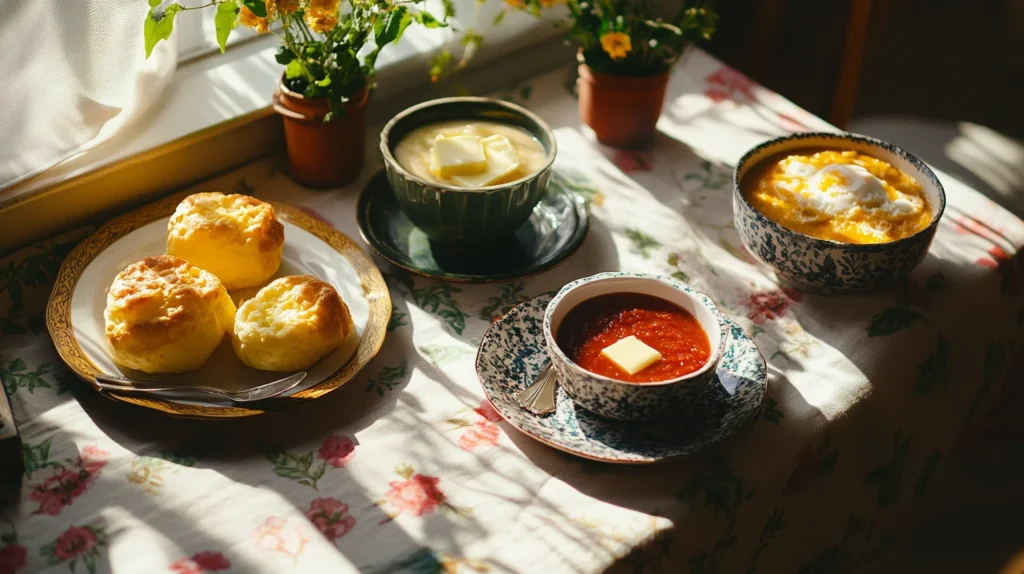
Once your golden cornmeal popovers are out of the oven and slightly cooled, the question becomes: how should you serve them? Here are some delicious ideas that make the most of their flavor and texture.
Pairings
Cornmeal popovers are incredibly versatile and can be served at any meal. Here are a few pairing ideas to consider:
- With Soups and Stews: The crispy crust and fluffy interior make popovers an ideal side for hearty dishes like beef stew, creamy chowder, or tomato soup.
- As a Breakfast Bread: Serve them warm with butter, jam, or honey. Pair with scrambled eggs, bacon, or sausage for a Southern-inspired morning meal.
- Alongside Grilled Meats: Cornmeal’s natural sweetness and crunch complement smoky flavors. Try them with BBQ chicken, pulled pork, or steak.
- With a Cheese Plate: Their lightness contrasts beautifully with rich cheeses and charcuterie. Use mini popovers as a base for appetizers or bites.
Occasions
Cornmeal popovers are surprisingly flexible when it comes to occasions. Here’s when to show them off:
- Brunch Parties: These popovers look impressive and pair well with both sweet and savory brunch items. Serve them as a centerpiece next to fruit platters, quiches, or avocado toast.
- Holiday Dinners: Bring a twist to your bread basket during Thanksgiving, Christmas, or Easter by offering cornmeal popovers instead of rolls or cornbread.
- Potlucks and Picnics: Mini versions travel well and can be eaten at room temperature, making them perfect for on-the-go snacking.
- Weeknight Comfort Food: Even a simple dinner of soup and salad becomes something special when served with warm, freshly baked popovers.
Serve them warm straight from the oven, or gently reheat before plating. They’re best enjoyed fresh but still shine even after cooling.
Cornmeal popovers shine in any setting:
- With breakfast: Pair with Healthy Smoothie Recipes for a complete morning meal.
- Alongside dinner: A great side for rich dishes like Pot BBQ Chicken.
Health Benefits and Nutritional Value
While popovers are often thought of as indulgent, adding cornmeal brings several nutritional perks to the table. It’s not just about taste — it’s about making your baking a little smarter and more wholesome too.
The Power of Cornmeal
Cornmeal, made from ground dried corn, is a naturally gluten-free whole grain.Here are some of the nutrients it brings:
- Fiber supports healthy digestion and helps regulate blood sugar levels.
- Iron and Magnesium: Essential for energy production, muscle health, and oxygen circulation.
- Antioxidants: Especially in yellow cornmeal, which contains carotenoids like lutein and zeaxanthin, beneficial for eye health.
- Complex Carbohydrates: Provide sustained energy without spikes or crashes.
When combined with protein-rich eggs and calcium from milk, cornmeal popovers become a more balanced bread option. Compared to traditional white bread rolls, they offer a slightly better nutritional profile, especially if you use whole-grain cornmeal and pair them with healthy toppings like nut butters, avocado, or grilled vegetables.
Light and Airy Yet Satisfying
Thanks to their high egg content and low added fat, popovers — even with cornmeal — are relatively low in calories compared to dense muffins or biscuits. Their structure makes them filling without being heavy, which is great for those watching portion sizes or aiming for a lighter meal side.
Of course, like any baked good, moderation is key. But when enjoyed mindfully, cornmeal popovers can be a satisfying and nutritious addition to your diet.
Common Mistakes and How to Avoid Them
Even experienced bakers can struggle with getting popovers just right. Here are the most common mistakes people make when baking cornmeal popovers, and how to avoid them for guaranteed success.
Mistake 1: Not Preheating the Pan
Why it matters: A hot pan creates the blast of steam that causes the batter to puff up rapidly. Skipping this step usually results in flat, dense popovers.
Fix: Always place your pan in the oven during preheating and work quickly when pouring the batter.
Mistake 2: Using Cold Ingredients
Why it matters: Cold milk or eggs can slow down the steam reaction, making it harder for the popovers to rise.
Fix: Let all ingredients sit at room temperature for at least 30 minutes before mixing.
Mistake 3: Overmixing the Batter
Why it matters: Overmixed batter develops gluten and air pockets, leading to tough, uneven popovers.
Fix: Mix just until combined and smooth. A few lumps are okay.
Mistake 4: Opening the Oven Door Too Soon
Why it matters: Popovers rely on hot air and steam to rise. Opening the oven too soon lets out heat and can cause the popovers to collapse.
Fix: Keep that oven door closed for at least the first 20 minutes!
Mistake 5: Adding Too Many Mix-ins
Why it matters: While variations are fun, adding too much cheese, fruit, or vegetables can weigh the batter down.
Fix: Stick to small amounts — no more than ½ cup of extras per batch.
Gluten-Free and Vegan Options
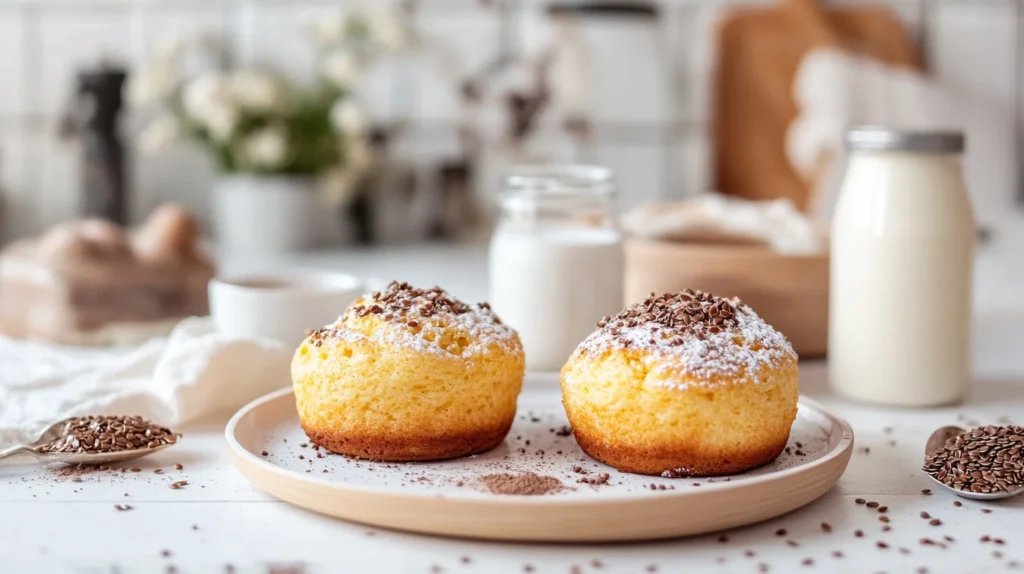
Everyone deserves a warm, fresh popover, and with a few simple substitutions, cornmeal popovers can be made suitable for a variety of diets.
Gluten-Free Cornmeal Popovers
Cornmeal is naturally gluten-free, but all-purpose flour isn’t. Luckily, you can still achieve that iconic puff by using one of the following:
- 1:1 Gluten-Free Flour Blend: These mimic the behavior of regular flour, making them the easiest substitution.
- Rice Flour + Tapioca Starch: Use a 70/30 blend of rice flour and tapioca starch for structure and elasticity.
- Almond or Oat Flour: For a nutty flavor, although results may be denser.
Tip: Let gluten-free batter rest a little longer (20–30 minutes) to allow hydration and better structure.
Vegan Cornmeal Popovers
Removing eggs is tricky, as they are the primary leavening agent. However, there are workarounds:
- Egg Replacement: Use aquafaba (chickpea water), flaxseed meal (1 tbsp flax + 3 tbsp water per egg), or commercial egg replacers.
- Milk Substitute: Choose unsweetened plant-based milk like almond, oat, or soy.
- Butter Substitute: Use vegan butter or neutral oil.
Note: Vegan versions won’t puff as dramatically but will still taste delicious and maintain a satisfying texture. They’re especially good with savory add-ins to enhance flavor.
Storage and Reheating Tips
Cornmeal popovers are best enjoyed fresh from the oven, but that doesn’t mean you can’t save leftovers. With the right storage and reheating methods, you can still enjoy their golden crust and fluffy interior hours—or even days—later.
Short-Term Storage
If you plan to eat your popovers within a day:
- Let Them Cool: Always allow them to cool completely before storing. Trapping steam leads to sogginess.
- Paper Towel + Container: Wrap popovers in paper towels and place them in an airtight container. Keep at room temperature for up to one day.
Avoid sealing them while warm or placing them in plastic wrap, as this can cause the crust to soften.
Longer-Term Storage
For storing beyond a day or two:
- Refrigeration: Place cooled popovers in an airtight container or zip-lock bag and refrigerate for up to 3 days. Keep in mind they might lose some of their crispness.
- Freezing: Popovers freeze surprisingly well. Individually wrap each popover in foil or plastic, then store them in a freezer-safe bag. They’ll keep well in the freezer for up to a month.
Pro Tip: Label and date your frozen popovers so you can keep track of freshness.
Reheating Tips
To restore that crisp edge and soft center:
- Oven Method: Preheat to 350°F (175°C), place popovers directly on the oven rack, and heat for 5–10 minutes. This helps revive their texture.
- Toaster Oven: Perfect for 1–2 popovers. Bake for 6–8 minutes at 325°F (160°C).
- Avoid Microwaving: Microwaves make popovers chewy or rubbery. It’s quick, but the texture suffers.
Cornmeal Popovers in Modern Cuisine
In recent years, cornmeal popovers have found their way into innovative kitchens and food trends around the world. No longer just a side dish, they’re being reimagined by chefs and home cooks alike.
Restaurant-Level Twists
Modern restaurants are elevating the humble popover with gourmet flavors and elegant plating:
- Truffle Butter Popovers: Brushed with truffle oil and topped with flaky sea salt, these appear in upscale steakhouses.
- Cornmeal Popover Sliders: Mini versions sliced in half and used as a base for gourmet sliders with pulled pork, pickled onions, or fried chicken.
- Brunch Boards: Popovers served with small bowls of herbed butter, spiced jams, and soft cheeses — a fresh take on charcuterie.
International Fusion
Cornmeal popovers are also being used as a base for global flavors:
- Korean-Inspired: Filled with kimchi and gochujang-spiced mayo.
- Mexican Street Corn Style: Finished with crumbled cotija cheese, zesty lime crema, and a sprinkle of chili powder.Mexican Street Corn Style: Topped with cotija, lime crema, and chili powder.
- Mediterranean Touch: Served with hummus, za’atar, and olive tapenade.
These fusions reflect how versatile cornmeal popovers are — adaptable to flavors from all over the world while keeping that signature puff.
Social Media Popularity
Platforms like Instagram and TikTok have helped these golden beauties go viral. Bakers share satisfying videos of rising popovers, crispy crust reveals, and unexpected flavor pairings. Mini muffin-tin popovers, gluten-free versions, and even air fryer experiments are fueling their trendiness.
Frequently Asked Questions
What is the secret to good popovers?
The secret to perfect popovers lies in three critical elements: a hot pan, room-temperature ingredients, and not opening the oven door during baking. Preheating the pan ensures a rapid steam burst that causes the batter to puff dramatically. Using room-temperature eggs and milk helps the batter blend more smoothly and activate more quickly in the oven. And finally, patience is key — opening the oven too early releases steam and causes the popovers to deflate before setting.
Also, using the correct ratio of eggs to flour gives the batter just the right amount of structure to expand and stay tall after baking. Lastly, letting the steam escape after baking — by poking a small hole in each popover — helps maintain their crisp outer texture.
Can I use cornmeal instead of flour?
Cornmeal can’t fully replace flour in popovers because it lacks gluten, which provides the structural integrity needed for the dramatic rise. However, you can combine cornmeal with all-purpose flour to add texture and flavor. A common ratio is about 1 part cornmeal to 3 parts flour. This ensures the popovers retain their classic airy structure while gaining the nutty flavor and subtle crunch of cornmeal.
If you’re trying to bake gluten-free, substitute the flour with a 1:1 gluten-free flour blend and still include some cornmeal for the unique texture. Just avoid using only cornmeal, or the batter will be too heavy and won’t rise properly.
What is the difference between Yorkshire pudding and popovers?
While Yorkshire pudding and popovers share a similar batter — made from flour, eggs, and milk — they have key differences in preparation and purpose:
Fat Source: Yorkshire puddings are traditionally baked in beef drippings or other meat fat, giving them a rich, savory flavor. Popovers are usually made with butter or neutral oil.
Pan Type: Yorkshire pudding is often made in roasting pans or muffin tins with deeper wells. Popovers are typically baked in dedicated popover pans with straight, tall sides to encourage a bigger rise.
Origin and Use: Yorkshire pudding originates from England and is served as part of a traditional roast dinner. Popovers are more popular in the United States and are often served as breakfast or a side dish.
Despite the differences, both are loved for their crispy exteriors and hollow, soft interiors.
What are the biggest causes of popover failures?
The most common popover failures usually boil down to technique:
Cold Ingredients: Using cold eggs or milk slows steam production, which is essential for the rise.
Overmixing: Mixing too aggressively can develop gluten and make the batter too dense.
Cold Pan: If the baking pan isn’t properly preheated, you won’t get that initial steam surge.
Opening the Oven Door Too Soon: This sudden drop in temperature can deflate the popovers.
Overloading with Mix-ins: Heavy additions like too much cheese or fruit weigh the batter down and prevent proper rising.
Follow the core techniques carefully, and you’ll significantly increase your success rate.
What type of flour is best for popovers?
The best flour for traditional popovers is all-purpose flour. It has the right protein content to develop just enough gluten to hold the structure without making the popovers too chewy or dense. Some bakers experiment with bread flour to get a chewier texture or cake flour for extra lightness, but these flours can be tricky to balance and may alter the signature popover consistency.
If you’re mixing in cornmeal, stick with all-purpose flour to give the batter the strength it needs to rise tall and hold shape.
Should you let popover batter rest?
Yes — resting the batter is highly recommended and makes a noticeable difference. Allowing the batter to rest for at least 15–30 minutes at room temperature helps the flour fully absorb the liquid, leading to smoother texture and more even rising. Some bakers rest the batter for up to an hour or refrigerate it overnight (though this can affect the puff slightly).
When resting overnight, be sure to bring the batter back to room temperature before baking. This encourages better expansion and a more defined popover structure.
Conclusion
Cornmeal popovers offer the perfect blend of classic comfort and contemporary flair. By combining the airy elegance of traditional popovers with the rustic charm of cornmeal, these golden treats bring something truly special to your table. Whether you’re serving them for a holiday feast, a casual brunch, or as a creative side dish for soups and stews, cornmeal popovers are endlessly adaptable and always crowd-pleasing.
With simple ingredients, a few smart techniques, and room for endless flavor variations, anyone—from first-time bakers to seasoned chefs—can master the art of the cornmeal popover. Add-ins like cheddar, herbs, cinnamon, or citrus zest only enhance their appeal, and with tips on gluten-free and vegan options, no one has to miss out.
Now that you know the secrets—hot pans, room-temperature ingredients, and plenty of creativity—it’s time to preheat that oven and start baking. Your next batch of cornmeal popovers might just become your new go-to recipe.🧁🧁🧁

Cornmeal Popovers
Equipment
- Popover pan (or muffin tin)
- Mixing bowls
- Whisk
- Measuring cups and spoons
- Oven
- Cooling rack
Ingredients
- ¾ cup all-purpose flour
- ¼ cup medium-grind cornmeal
- ½ teaspoon salt
- 1 ¼ cups whole milk room temperature
- 3 large eggs room temperature
- 2 tablespoons unsalted butter melted, plus more for greasing pan
Instructions
- Preheat the oven to 450°F (230°C) and place your popover pan inside while it heats.
- In a large bowl, whisk together flour, cornmeal, and salt.
- In another bowl, beat the eggs and milk until well combined.
- Gradually add wet ingredients to dry, whisking gently until just combined.
- Stir in the melted butter. Let the batter rest for 10–15 minutes.
- Remove the hot pan from the oven and grease each cup thoroughly.
- Pour the batter into the cups, filling each about ⅔ full.
- Bake at 450°F for 15 minutes without opening the oven.
- Reduce heat to 350°F (175°C) and bake for another 20 minutes, or until puffed and golden.
- Immediately pierce each popover with a sharp knife to release steam.
- Let cool slightly on a wire rack and serve warm.
